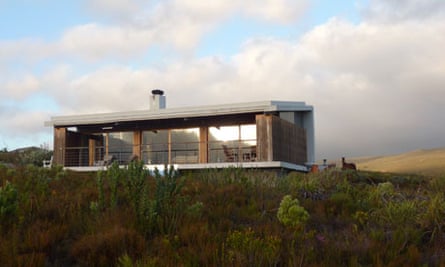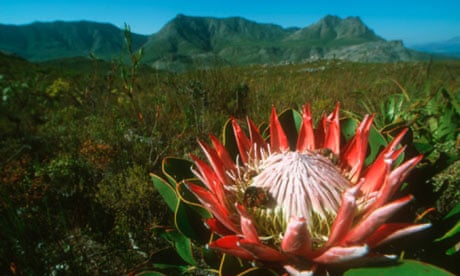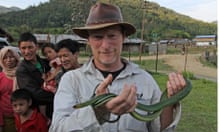For five days and nights in February 2006, the fire blazed a 50-mile trail from the outskirts of Cape Town down towards Africa's southernmost point. Then, unexpectedly, the wind changed direction – meaning workers and fire staff at the Grootbos Private Nature Reserve stood no chance against the flames. Conference guests had to be hurriedly evacuated before the lodge complex was completely engulfed. Three apartments were destroyed, and the five-star restaurant's collection of Western Cape wines was reduced to a mountain of twisted glass.
So how come Grootbos's chief botanist, Sean Privett, is smiling as he recalls that dramatic night?
"Hey, they were just buildings, they could be rebuilt," he says with a grin. "But that fire was also a whole new opportunity for rare plant species to germinate and flourish. We found something like 70 new species here in the months after the blaze."
Then, like a proud parent, he opens his arms to the dense shrubland around him: "With the exception of our ancient milkwood forest, which is fire resistant, you can say that all the plants here were born on the same day: 6 February 2006."
Sean, we discover, is not the only person around here who is fanatical about flowers. This beautiful stretch of South Africa's Western Cape, known as the Overberg, may be a prime spot for watching whales and great white sharks, but for many of its landowners the priority is protecting the proteas, orchids, ericas and carniverous sundew plants (to name but four of the region's floral families) which make up the fynbos, shrubland with as rich an array of plant species as you'll find anywhere on the planet. Grootbos's conservation efforts began 20 years ago, when Heiner Lutzeyer and his son Michael bought the original 123-hectare farm, and Heiner started photographing and documenting its indigenous flora. (Of the six completely new species that have since been discovered here, two – Lachenalia lutzeyeri and Capnophyllum lutzeyeri – have been named after him … not bad for an amateur botanist.)
These days, the reserve stretches to some 1,750 hectares. And while guests are treated to the height of five-star luxury – including what may be the world's finest view direct from a bathtub – it is clear that conservation, including a strong commitment to educating and employing workers from the poorest local communities, remains the primary concern in what the Grootbos website calls this "botanic wonderland".
There's just one thing ...
I daren't mention this to Sean but, following our hour-and-a-half's drive down from Cape Town through dustbowl-dry arable fields, I'm feeling a little confused. We have been greeted by a stunning mountainous coastline, certainly – but not quite the explosion of floral colour I'd been expecting. Rather, it's a plainish green moorland typical of parts of Scotland. Can we really be in the heart of the smallest but most precious of the world's six designated floral kingdoms, with – according to my guidebook – species far outnumbering those found in the entire Amazon rainforest?
Fortunately, in addition to beach horse riding and whale watching (best between June and December), Grootbos also lays on a trademark "flower safari" to introduce guests to the most striking flora on the reserve. And today we're lucky enough to have Sean and his battered old Jeep guiding us. First question, then: what's the floral equivalent of seeing a lion?
Graciously, Sean offers no hint that this inquiry might be unworthy of one of South Africa's foremost botanical experts. Instead, at the highest point of the Grootbos reserve, he yanks on the handbrake and bounds off into the middle of the knee-high shrubland. I have to admit, though, that what appears uniformly green from a distance is anything but when you are in the thick of it. As we try to follow Sean's identifying yells, bright flashes of colour and scent assault us from all directions. Among them delicate pinks and yellows of little erica plants, heather-like flowers that at the right times of year bathe whole valleys in a pink, yellow or white wash.
No two neighbouring plants, it seems, are ever allowed to hail from the same species. It's as if the fynbos has been designed by a mad botanist who's been overdoing it on the organic fertiliser.
"Over here!" Sean shouts, pointing at a large and slightly sun-withered white flower guarded by tall, bright pink spikes. "King Protea, the biggest of all the Protea family and the national flower of South Africa … here's that lion you were after."
By the end of the safari, I've lost count of how many weird and wonderful species we have encountered – from spectacular crimson candelabra flowers that detach and roll along with the wind, to the orange-flowered and not-at-all-potent wild marijuana plants. In danger of joining the ranks of the florally obsessed myself, I ponder out loud why there should be quite so many different species of plant here.
"Er, we're not actually sure," Sean says, disarmingly. "There are so many factors … the lack of any ice ages; all the different types of nutrient-poor soil; the weather systems rolling up from Antarctica; and the fact this region has never been farmed intensively. It's just a really unusual cocktail."
Speaking of alcohol – and it's hard not to in the Western Cape, one of the world's great wine regions – those nutrient-poor soils are also proving increasingly attractive to winemakers, who reckon tricky soils produce more interesting wines because the grapes have to work harder. But rather than proving an irritant to local conservationists, the neighbouring Lomond wine estate belongs to the region's pioneering "biodiversity and wine initiative", which pledges to protect rare and endangered plant species by only using sustainable farming methods.
Similarly, the nearby Flower Valley Farm, which grows indigenous fynbos plants for the cut-flower trade (including M&S in Britain), is run by a public conservation trust which ensures that neither the fynbos nor local workers are exploited for profit.
Almost everyone, it seems, understands the fragility of the ecosystem here – and with good reason. One recent report counted the Cape Floristic Region as among the 10 places in the world most threatened by climate change: a predicted temperature rise of 1.8C over the next 40 years would spark a dramatic increase in the number of wildfires like the one that did so much damage in 2006. The eco equation says the fynbos needs fire to flourish – but not too often, or it will be wiped out entirely.

Maarten Groos is another veteran of that 2006 fire. The manager and co-owner of Farm 215, an even more secluded retreat with a stunning view down to the Lomond lake and vineyards, watched as the flames scorched his newly built lodges, yet he too talks only of the benefits it brought to this fragile landscape.
Perched right in the middle of the fynbos, the facilities at Farm 215 are as uncompromising as they are luxurious – a refusal to add chemicals means the drinking water is a peaty yellow and the bath water a teaky brown; the three "fynbos suites" are solar-powered.
After a delicious dinner on our first night, Maarten gets out an album of photographs he took in the months after the fire, detailing the emergence of one particular flower species. The Moraea lurida iris only ever appears here immediately after fire has cleared the landscape of all the other, more bullish, plant species. Like another proud parent, Maarten delights in showing off images of these beautiful, deep purple flowers emerging across the hillside – and describing the scent of rotting meat they give off to attract flies for pollination.
Yet the photographs show that, before long, these irises have disappeared again, not to be seen until the next major fire. Even to the uninitiated, staying in the midst of such a precious ecosystem – sharing the knowledge and hospitality of such committed conservationists – is clearly a rare privilege.


